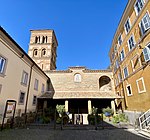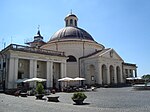Albano Laziale

Albano Laziale (IPA: [alˈbaːno latˈtsjaːle]; Romanesco: Arbano; Latin: Albanum) is a comune in the Metropolitan City of Rome, on the Alban Hills, in Latium, central Italy. Rome is 25 kilometres (16 mi) distant. It is bounded by other communes of Castel Gandolfo, Rocca di Papa, Ariccia and Ardea. Located in the Castelli Romani area of Lazio. It is sometimes known simply as Albano. Albano is one of the most important municipalities of the Castelli Romani, and a busy commercial centre. It has been also a suburbicarian bishopric since the 5th century, a historic principality of the Savelli family, and from 1699 to 1798 the inalienable possession of the Holy See. It now houses, among other things, the Praetor of the district court of Velletri. The territory of Albano is partially included in the Parco Regionale dei Castelli Romani.
Excerpt from the Wikipedia article Albano Laziale (License: CC BY-SA 3.0, Authors, Images).Albano Laziale
Via di Ariccia,
Geographical coordinates (GPS) Address Nearby Places Show on map
Geographical coordinates (GPS)
| Latitude | Longitude |
|---|---|
| N 41.733333333333 ° | E 12.666666666667 ° |
Address
Via di Ariccia
00041
Lazio, Italy
Open on Google Maps










